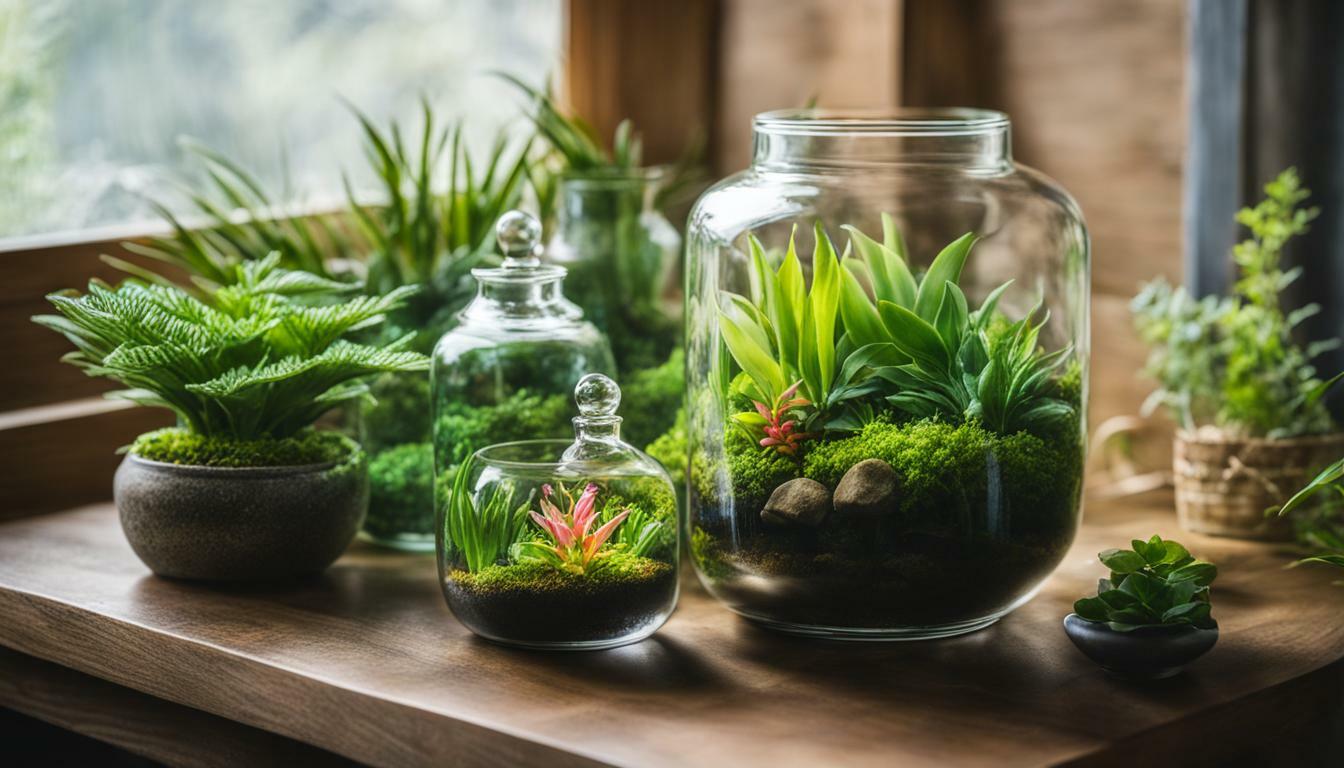Welcome to our guide to terrarium plants and aquatic plants, designed to help you create a thriving home garden filled with lush greenery. Whether you are a beginner or an experienced gardener, this comprehensive guide will provide you with all the information you need to choose and care for the perfect plants for your terrarium.
- Terrariums are glass containers that provide a controlled environment for plants to grow.
- There are two types of terrariums: open and closed, each with different humidity levels.
- Humidity-loving plants thrive in closed terrariums, while arid plants prefer open terrariums.
- When choosing plants, consider their natural habitat, size, and growth rate.
- Popular terrarium plants include air plants, haworthia, jade plants, button ferns, and string of pearls.
Proper care for terrarium plants involves providing the right amount of light, ventilation, and regular watering and pruning. By following our guide, you can create a beautiful and thriving terrarium garden that will bring joy and tranquility to your home.
Understanding Terrariums: Open vs. Closed
Terrariums come in two main types – open and closed, each offering a unique environment for your plants to thrive. Closed terrariums, as the name suggests, are sealed containers that create a mini greenhouse effect. This type of terrarium retains moisture and humidity, making it ideal for plants that thrive in a tropical or humid environment. Popular choices for closed terrariums are humidity-loving plants such as artillery ferns, aluminum plants, and polka dot plants. These plants enjoy the high humidity levels and minimal air circulation provided by closed terrariums. They are visually appealing with their lush foliage and can add a touch of green to any indoor space.
On the other hand, open terrariums have lower humidity levels and allow for more air circulation. This type of terrarium is suitable for arid plants like cacti and succulents that thrive in drier conditions. Open terrariums provide an environment similar to their natural habitat, allowing these plants to flourish. They require less frequent watering and can tolerate periods of drought. Air plants, haworthia, jade plants, button ferns, and string of pearls are great options for open terrariums. These plants have adapted to drier conditions and are easy to care for, making them perfect for beginners.
When selecting plants for your terrarium, it is important to consider their natural habitat, size, and growth rate. Opt for plants that are compact and slow-growing to prevent overcrowding within the terrarium. It’s also worth noting that some plants may require specific light conditions, so be sure to choose plants that are compatible with the available light in your chosen location. With the right selection of plants and proper care, you can create a beautiful and thriving terrarium that brings a piece of nature into your home.
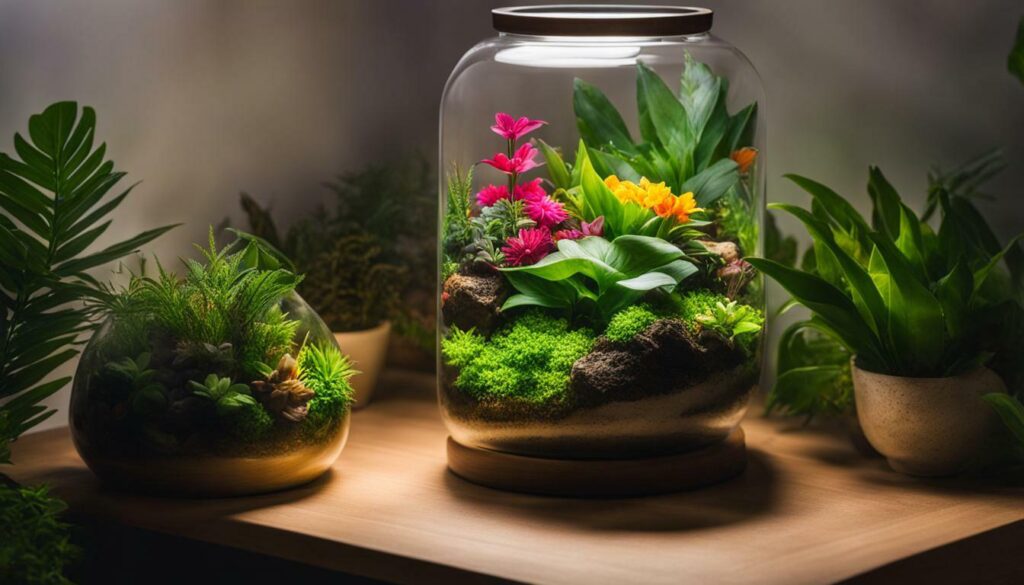
| Type of Terrarium | Recommended Plants |
|---|---|
| Closed Terrarium | Artillery ferns, Aluminum plants, Polka dot plants |
| Open Terrarium | Air plants, Haworthia, Jade plants, Button ferns, String of pearls |
Choosing the Right Terrarium Plants
When it comes to choosing terrarium plants, there are plenty of options to consider, from common and popular choices to a wide range of tropical varieties. These plants add beauty and vibrancy to any terrarium setting, whether it’s an open or closed environment. It’s important to select plants that are well-suited for the specific conditions of your terrarium, such as light levels, humidity, and growth habits.
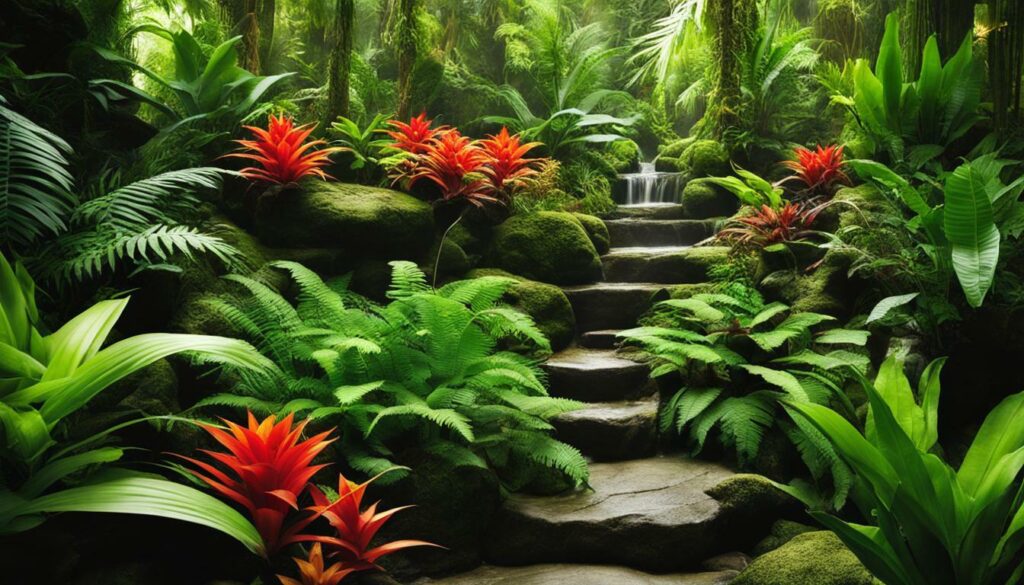
One popular choice for open terrariums is the air plant, which doesn’t require soil and absorbs moisture and nutrients from the air. Haworthia is another excellent option, known for its striking succulent leaves and low maintenance requirements. Jade plants are great for their resilience and ability to thrive in various conditions, making them a versatile choice for terrariums.
If you prefer a more delicate and trailing plant, consider button ferns and string of pearls. The button fern features small, button-like leaflets that add texture to the terrarium, while string of pearls has cascading stems covered in round, bead-like leaves. Both plants create a whimsical and enchanting effect.
Tropical Terrarium Plant Varieties
If you’re looking to create a tropical oasis within your terrarium, there are numerous tropical plant varieties to choose from. These plants thrive in high humidity and warm temperatures, making them perfect for closed terrariums. Some popular tropical choices include the artillery fern, aluminum plant, and polka dot plant. The artillery fern has delicate, feathery leaves and adds a touch of elegance to any terrarium. The aluminum plant features striking silver markings on its leaves, while the polka dot plant boasts colorful foliage with splashes of pink, red, or white.
In conclusion, when selecting terrarium plants, consider the specific needs of your terrarium and the desired aesthetic. Whether you opt for common choices like air plants and jade plants or explore tropical varieties, there is a wide range of plants that can thrive in a terrarium setting. Remember to provide the right amount of light, proper ventilation, and regular watering and pruning to ensure the health and longevity of your terrarium plants.
Caring for Terrarium Plants
Giving your terrarium plants the right care is essential for their overall health and longevity. Terrariums create a unique microclimate that requires specific care techniques to ensure the plants thrive. Here are some key aspects of terrarium plant care to keep in mind:
Proper Ventilation
Good air circulation is crucial for the health of your terrarium plants. While closed terrariums create a humid environment, it’s essential to provide proper ventilation to prevent the growth of mold or fungus. You can achieve this by opening the lid of your closed terrarium for a few hours each week. For open terrariums, ensure they are placed in a well-ventilated area to prevent stagnant air.
Regular Watering and Pruning
Watering is a critical aspect of terrarium plant care. The moisture needs of your plants will depend on their specific requirements, but in general, it’s important to water them when the soil feels dry to the touch. Overwatering can lead to root rot, so it’s better to underwater than overwater. Additionally, regular pruning is necessary to maintain the desired shape and size of your plants. Remove any dead or yellowing leaves to promote healthy growth.
By providing proper ventilation, regular watering, and pruning, you can ensure that your terrarium plants thrive and add beauty to your home garden. Remember to consider the specific needs of each plant and adjust your care routine accordingly. With the right care, your terrarium plants will flourish and create a stunning, miniature ecosystem within your home.
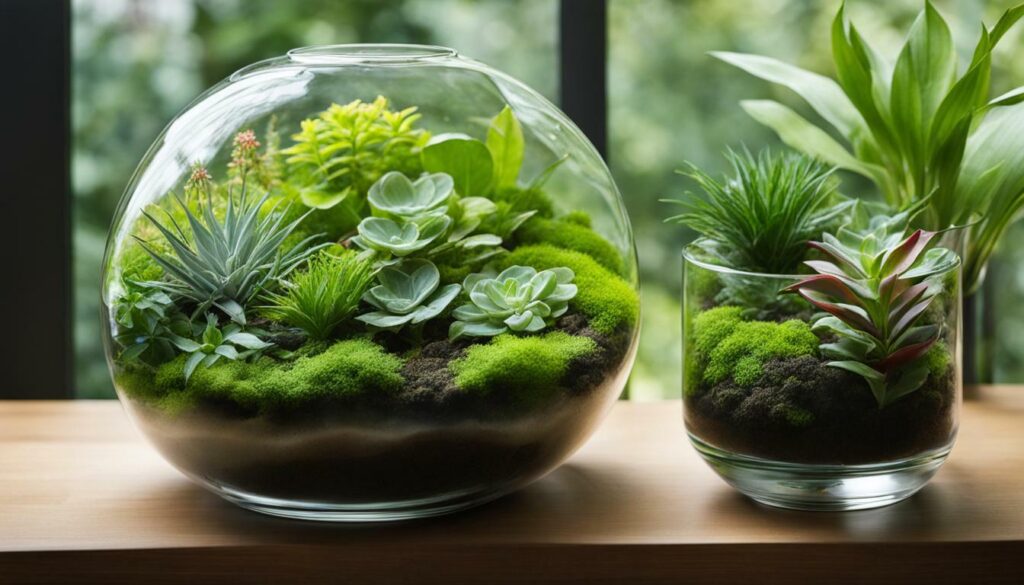
| Terrarium Plant | Light Requirements |
|---|---|
| Air Plants | Indirect, bright light |
| Haworthia | Medium to bright, indirect light |
| Jade Plant | Bright, direct light |
| Button Ferns | Low to medium, indirect light |
| String of Pearls | Bright, indirect light |
Light Requirements for Terrarium Plants
The right amount of light is crucial for the growth and development of your terrarium plants. Different plants have different light requirements, and understanding these needs is key to maintaining a healthy and thriving terrarium. In this section, we will explore the types of lighting conditions that suit terrarium plants, particularly low-light aquatic plants.
Low-light aquatic plants are ideal for terrariums because they can thrive in environments with limited natural light. These plants have adapted to survive in shaded areas, making them perfect for indoor terrariums or spaces with minimal sunlight. Some popular low-light aquatic plants include Java fern, Anubias, and Amazon sword.
To ensure that your low-light aquatic plants receive adequate light, place your terrarium in a location that receives indirect sunlight or artificial light sources. Keep in mind that direct sunlight can cause overheating and damage the delicate ecosystem within your terrarium.
“Low-light aquatic plants are ideal for terrariums because they can thrive in environments with limited natural light.”
It’s important to regularly monitor the light conditions in your terrarium and make adjustments as needed. If you notice that your plants are not thriving or are showing signs of yellowing or stunted growth, it may be an indication that they need more light. On the other hand, if your plants are growing too quickly or appear leggy, they may be receiving too much light.
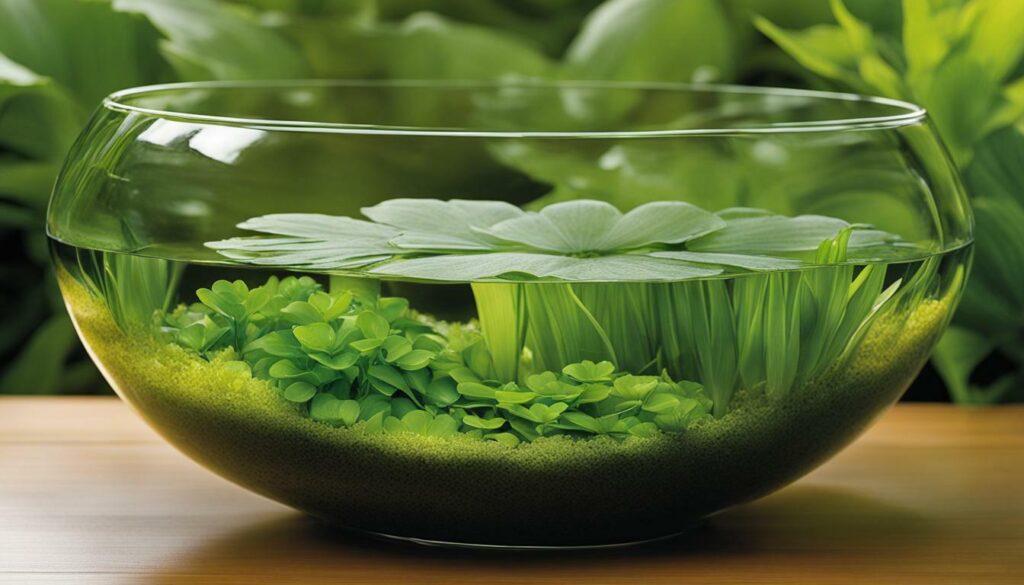
Table: Low-Light Aquatic Plants for Terrariums
| Plant | Light Requirements |
|---|---|
| Java fern | Low to moderate light |
| Anubias | Low to moderate light |
| Amazon sword | Low to moderate light |
Remember that each terrarium is unique, and the lighting requirements may vary depending on the size, type of plants, and the environment in which the terrarium is placed. Regularly assess the condition of your plants and make adjustments as necessary to ensure they thrive in their enclosed ecosystem.
Watering and Humidity Control in Terrariums
Maintaining proper watering and humidity levels in your terrarium is key to the success of your plants. Closed terrariums provide a humid environment, making them ideal for humidity-loving plants such as artillery ferns, aluminum plants, and polka dot plants. These plants thrive in high levels of moisture and will suffer if exposed to dry conditions.
To ensure the humidity remains optimal in a closed terrarium, it is important to keep the lid tightly closed. This will help create a self-contained ecosystem where moisture can circulate and be retained. However, it’s essential to monitor the moisture levels regularly to prevent excessive condensation or mold formation.
Open terrariums, on the other hand, have lower humidity levels. They are better suited for arid plants like cacti and succulents. These plants have adapted to survive in drier conditions and require less moisture. When watering open terrariums, it’s important to do so sparingly to avoid waterlogging the plants and causing root rot.
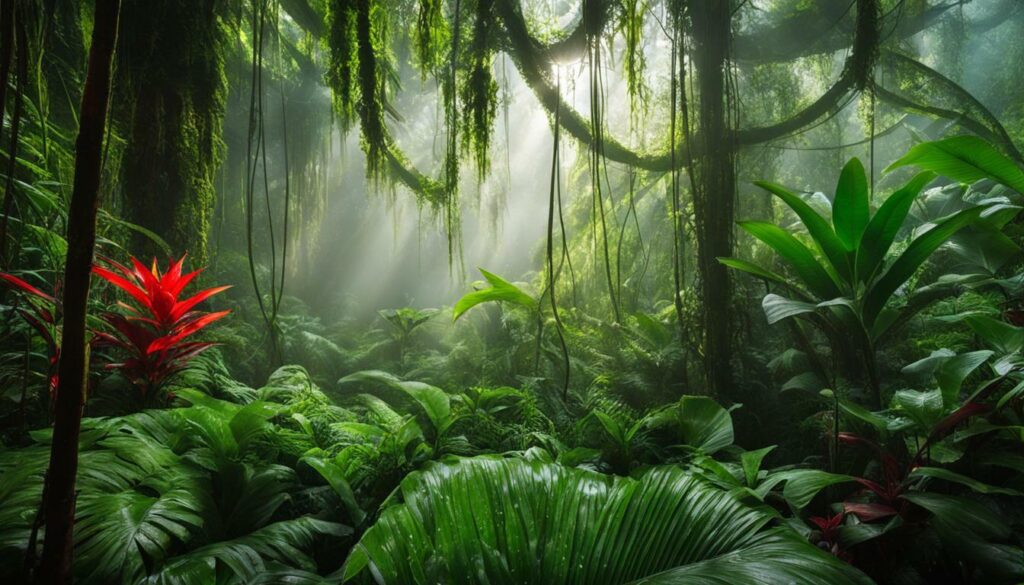
It’s important to remember that each terrarium is unique, and its watering and humidity requirements may vary. Factors such as the size of the terrarium, the type of plants, and the environmental conditions of your home will all play a role in determining the watering frequency. As a general guideline, it is advisable to water your terrariums sparingly, allowing the soil to dry out slightly between waterings.
| Terrarium Type | Humidity Requirements | Examples of Suitable Plants |
|---|---|---|
| Closed Terrarium | High humidity | Artillery ferns, aluminum plants, polka dot plants |
| Open Terrarium | Lower humidity | Cacti, succulents, air plants |
In addition to watering, it’s also crucial to maintain proper ventilation in your terrarium to prevent the buildup of excess moisture. This can be achieved by periodically opening the lid of a closed terrarium or ensuring adequate airflow around an open terrarium. Regularly inspect your terrarium for any signs of moisture imbalance, such as wilting leaves, mold growth, or a musty smell, and make adjustments accordingly.
By understanding and implementing the appropriate watering and humidity control measures, you can create a thriving environment for your terrarium plants. Take the time to observe and learn the specific needs of each plant, and you’ll be rewarded with a beautiful and healthy miniature garden.
Troubleshooting Common Terrarium Plant Issues
Even with the best care, terrarium plants can sometimes face challenges that require attention and intervention. Being aware of common issues and knowing how to address them can help ensure the health and vitality of your terrarium plants. Here are a few troubleshooting tips for some common terrarium plant problems:
Yellowing leaves:
If you notice that the leaves of your terrarium plants are turning yellow, it could indicate several possible issues. One common cause is overwatering. Terrariums typically have a closed or semi-closed environment, and excessive moisture can lead to root rot. To remedy this, adjust your watering schedule and make sure the terrarium has proper drainage. Another possible cause of yellowing leaves is inadequate light. Remember to consider the lighting requirements of your specific plants and provide sufficient light accordingly.
Overwatering:
Overwatering is a common mistake that can harm terrarium plants. It’s crucial to strike a balance between providing enough moisture for the plants’ needs and avoiding excessive watering. To prevent overwatering, allow the top layer of soil to dry out slightly between watering sessions. Additionally, ensure that your terrarium has sufficient drainage to prevent water from pooling at the bottom. If you suspect your plants are suffering from overwatering, let the soil dry out completely before resuming a regular watering routine.
Pest infestations:
Pests like aphids, mealybugs, or spider mites can occasionally find their way into your terrarium. These tiny invaders can damage plants and lead to reduced growth or even death if left untreated. To combat pest infestations, it’s important to regularly inspect your terrarium for any signs of pests. If you do notice a problem, take immediate action by isolating and treating affected plants. Use organic pest control methods such as neem oil or insecticidal soap, following the instructions carefully. It’s also a good idea to regularly clean and sanitize your terrarium to prevent pest problems from occurring in the first place.
“Even with the best care, terrarium plants can sometimes face challenges that require attention and intervention.”
By being proactive and addressing potential issues promptly, you can help your terrarium plants thrive. Remember to monitor their growth, provide the right conditions, and be mindful of any signs of trouble. With proper care and attention, your terrarium plants will continue to bring beauty and life to your home garden.
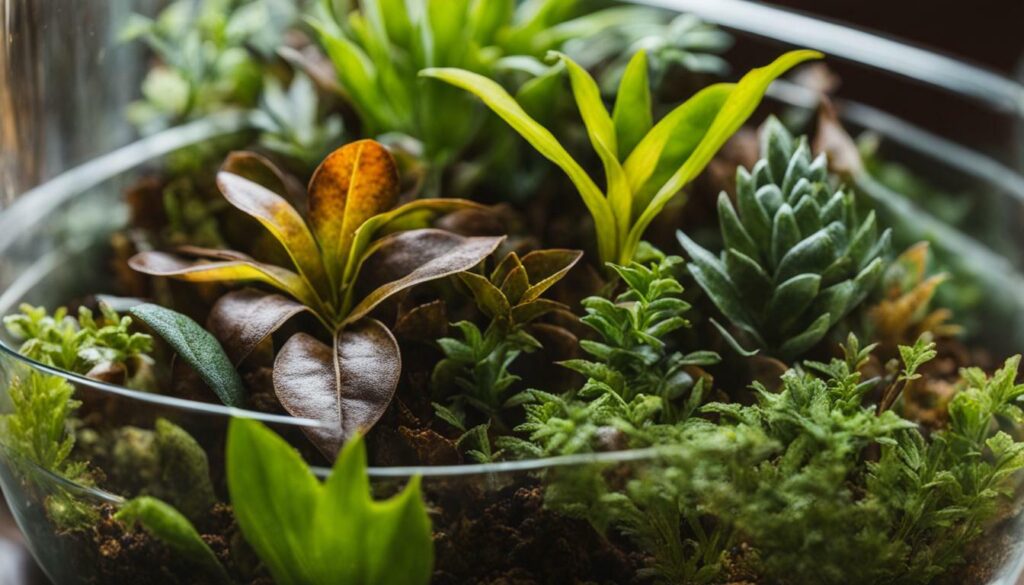
Expanding Your Terrarium Plant Collection
Once you’ve mastered the basics of terrarium plant care, you can explore a wider range of plants to expand your collection and create a stunning display. There are many options to choose from, including the best plants for terrariums, indoor aquatic plants, and easy-care terrarium plants. Whether you want to add more diversity to your terrarium or focus on specific themes, here are some suggestions to help you expand your plant collection.
Best Plants for Terrariums
When selecting plants for your terrarium, consider their natural habitat, size, and growth rate. Some popular choices for terrariums include air plants, haworthia, jade plants, button ferns, and string of pearls. These plants are known for their unique foliage and adaptability to terrarium environments. They come in various shapes, sizes, and colors, allowing you to create visually appealing arrangements.
Indoor Aquatic Plants
If you have a closed terrarium or are interested in adding aquatic elements to your terrarium, indoor aquatic plants are a great option. These plants thrive in humid environments and can add a touch of serenity to your terrarium. Some suitable choices include water lettuce, water hyacinth, and Java moss. These plants not only enhance the visual appeal of your terrarium but also help maintain the overall ecosystem balance.
Easy-Care Terrarium Plants
If you’re a beginner or prefer low-maintenance plants, there are plenty of easy-care terrarium plants to choose from. These plants require minimal attention and can thrive in a variety of terrarium conditions. Some examples include snake plants, pothos, spider plants, and zz plants. These plants are known for their durability and ability to adapt to different light and humidity levels, making them ideal for beginners or busy individuals.
By expanding your terrarium plant collection, you can create a more diverse and visually stunning display. Whether you choose the best plants for terrariums, indoor aquatic plants, or easy-care options, remember to consider the specific needs of each plant and provide the necessary care to ensure their growth and health.
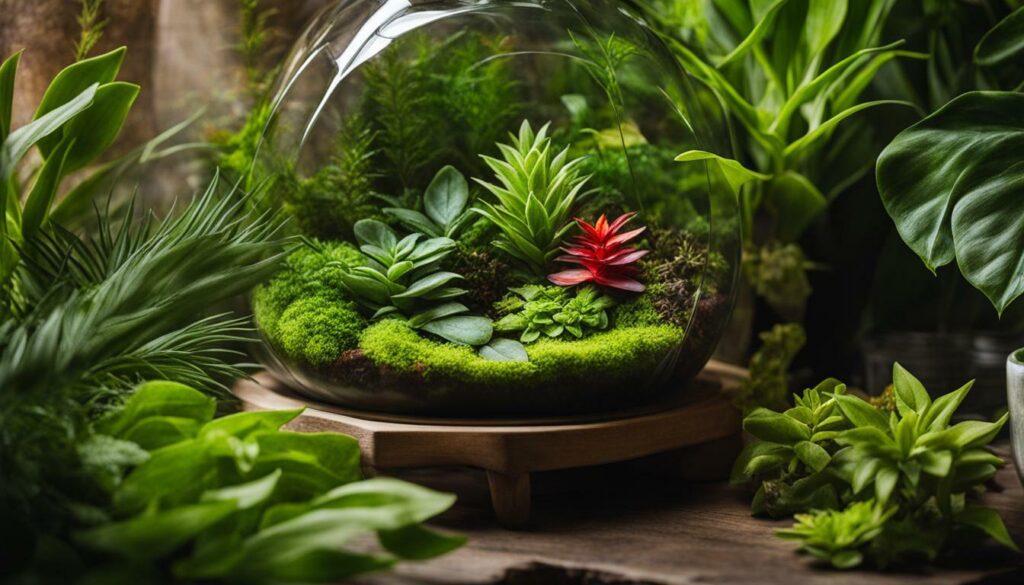
Creating a thriving terrarium garden is a rewarding endeavor that requires careful plant selection, proper care, and attention to the unique needs of terrariums. Terrariums are glass containers in which plants can be grown, and they come in two main types – open and closed. Closed terrariums provide a humid environment, perfect for humidity-loving plants like artillery ferns, aluminum plants, and polka dot plants. On the other hand, open terrariums have lower humidity levels and are suitable for arid plants like cacti and succulents.
When selecting plants for a terrarium, it is essential to consider their natural habitat, size, and growth rate. Some great choices for open terrariums include air plants, haworthia, jade plants, button ferns, and string of pearls. These plants are not only visually appealing but also relatively easy to care for, making them ideal for beginners.
Caring for terrarium plants involves providing the right amount of light, proper ventilation, and regular watering and pruning. Low-light aquatic plants are especially well-suited for terrariums, as they thrive in the typically limited light conditions. Additionally, maintaining the right levels of humidity is crucial, particularly for closed terrariums with humidity-loving plants.
While terrariums can bring a touch of nature and beauty to any home or office, they require attention and care to ensure the plants thrive. By following the tips and guidelines provided in this guide, you can create a stunning terrarium garden that will bring joy and tranquility to your space for years to come.
How do Terrarium Plants Differ from Aquatic Plants in Home Gardens?
Terrarium plants like prayer plants thrive in drier conditions and are better suited for indoor terrariums. On the other hand, aquatic plants require constant moisture and are best suited for underwater environments in home gardens. The key difference lies in their water and humidity requirements.
FAQ
What are terrariums?
Terrariums are glass containers in which plants can be grown. They can be open or closed, providing different environments for the plants.
What plants are suitable for closed terrariums?
Closed terrariums create a humid environment, making them perfect for humidity-loving plants like artillery ferns, aluminum plants, and polka dot plants.
What plants are suitable for open terrariums?
Open terrariums have lower humidity levels and are suitable for arid plants like cacti and succulents.
How do I choose plants for a terrarium?
When choosing plants for a terrarium, consider their natural habitat, size, and growth rate. Some great terrarium plants for open terrariums include air plants, haworthia, jade plants, button ferns, and string of pearls.
How do I care for terrarium plants?
Care for terrarium plants includes providing the right amount of light, proper ventilation, and regular watering and pruning.
What are the light requirements for terrarium plants?
Terrarium plants have varying light requirements. Some plants, like low-light aquatic plants, are well-suited for terrariums with limited light.
How do I control watering and humidity in terrariums?
Watering and humidity control in terrariums depend on the type of plants and the terrarium environment. Closed terrariums with humidity-loving plants require less watering, while open terrariums with arid plants need less humidity.
What are some common issues with terrarium plants and how do I troubleshoot them?
Common issues with terrarium plants include yellowing leaves, overwatering, and pest infestations. To troubleshoot these problems, adjust watering, improve ventilation, and address pests promptly.
How can I expand my terrarium plant collection?
To expand your terrarium plant collection, consider adding the best plants for terrariums, indoor aquatic plants, and easy-care options suitable for beginners.

